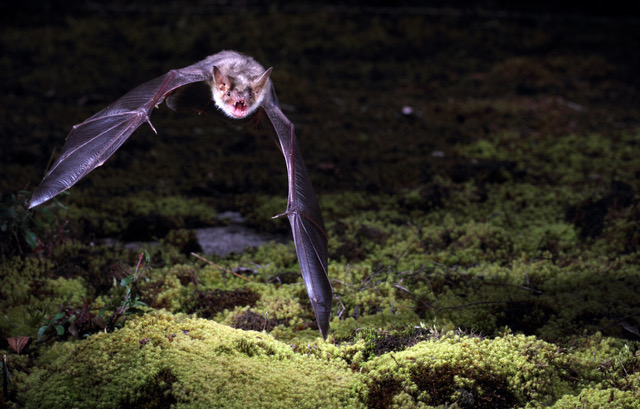 Evolution & Behaviour
Evolution & Behaviour
Bat genomes: unveiling the secrets of their superpowers
Bats possess many extraordinary adaptations, including echolocation, flight, unique immunity to viruses and extended longevity. To uncover the molecular basis underlying these traits, we have generated high-quality genomes of six bat species. These resources will improve our understanding of bat biology and stimulate new avenues of research that are relevant to human health and disease.

If you watch and listen carefully on a quiet summer's night in the open air, you might perceive some dark shadows flying around or hear some high-pitch chirps. Yes, you have probably guessed it right. These are bats who have just started their 'day' and are getting ready for a nice meal.
Scientists have long been puzzled by these little extraordinary mammals. They fly, can use echolocation to orient and find food in complete darkness, and play a key role in the functioning of our ecosystems, such as pest control, seed dispersal and pollination. Most enigmatically, they can harbour a plethora of deadly viruses without getting obviously sick, and can live much longer than other mammals with similar body size, showing little signs of ageing and low cancer incidence. But how bats can achieve all of these unique traits remains largely unknown.
The genetic basis behind these fascinating capabilities and physiological properties resides in bat genomes. To explore this, Bat1K have generated six high quality bat genomes that are the most complete and accurate amongst all bat genomes published to date, using the latest DNA sequencing technology and genome assembly pipelines. These six bat species(Greater horseshoe bat, Egyptian fruit bat, Pale spear-nosed bat, Velvety free-tailed bat, Kuhl's pipistrelle and Greater mouse-eared bat) represent a wide range of ecological and evolutionary diversity within bats. Using these genomes, we investigated where bats are located in the mammalian tree of life, how bats have evolved echolocation, and how they can tolerate viruses that are lethal to other mammals.
The position of bats within the mammalian tree of life has been a long-lasting, hotly debated evolutionary question. Using novel phylogenetic approaches, we analysed a comprehensive dataset from 48 high-quality mammalian genomes. We found strong evidence suggesting that bats are most closely related to Fereuungulata, a group of mammals including carnivores (e.g. dogs, cats, and seals), whales, pangolins and hoofed mammals, resolving this long standing issue.
To uncover the genomic changes that underlie the unique adaptations observed in bats, we scanned the genome in search of genes that differ between bats and other mammals. We found two genes associated with human diseases involving deafness, called LRP2 and SERPINB6, which seem to be linked with echolocation in bats. We also found that several genes regulating aspects of the immune system in mammals were lost in bat genomes.
The constant battles between animals and viral pathogens have begun since the early evolutionary stage of animals. Occasionally, certain type of viruses (retroviruses) infect sperm or egg cells and insert its genome into that of infected cell and can remain in cells after infection. If these cells survive and become an embryo, this new organism will contain the integrated viral elements as an inherent part of its genome. We found that bat genomes contained a surprisingly high diversity of viral elements or 'genomic fossils' of past viral infection – far more than other mammals – providing evidence of historic tolerance to past viral infection in bats.
These changes may underlie the genetic basis of laryngeal echolocation, exceptional immune system and bats' tolerance of coronaviruses.
High-quality genomes also provide a great opportunity to explore regions in the genome that control how and when other genes are active. We identified a striking case of specific adaptation in the regulatory regions of bat genomes, suggesting these may play a role in behavior, development and cancer in bats. Importantly, we have successfully validated this finding in the lab to show their consequence on gene regulation.
We believe that these six high-quality bat genomes provide a rich resource to uncover the evolutionary history and genomic basis of bats' rare and wonderful superpowers. However, this is just the start. Around 1,400 living bat species, which exhibit an incredible diversity in ecology, sensory perception, immunology and longevity, still remain to be sequenced. These genomic resources will be particularly important for studying the mechanisms of how bats can survive coronavirus infections, thus providing possible solutions to increase human survivability when future pandemics occur.
Original Article:
Jebb, D. et al. Six reference-quality genomes reveal evolution of bat adaptations. Nature 583, 578-584 (2020).
Next read: How did wild cats turn into our beloved domestic animals? by Magdalena Krajcarz , Maciej Krajcarz
Edited by:
Dr. Ayala Sela , Associate Editor
We thought you might like
How humans gave acne to the grapevine
Feb 28, 2015 in Evolution & Behaviour | 3.5 min read by Carlos J. Rivera-RiveraThe lingering effects of parental care and its role in evolutionary change
Jan 27, 2016 in Evolution & Behaviour | 4 min read by Rebecca KilnerLiving without mitochondria: the downfall of one textbook truth
Oct 3, 2016 in Evolution & Behaviour | 3.5 min read by Lukáš NovákFancy footwork: Darwin’s pigeons and the evolution of foot feathers
Jan 20, 2017 in Evolution & Behaviour | 3.5 min read by Eric DomyanMore from Evolution & Behaviour
Rudimentary form of syntax present in chimpanzees
Nov 29, 2023 in Evolution & Behaviour | 3 min read by Maël LerouxAn incredibly massive ancient whale skeleton reveals a new way to become a giant
Nov 27, 2023 in Evolution & Behaviour | 4 min read by Olivier LambertVikings and Migrants: Unravelling Scandinavia's Genetic Mosaic in the Viking Era
Nov 13, 2023 in Evolution & Behaviour | 3 min read by Anders Götherström , Ricardo Rodríguez VarelaFish identify themselves in mirrors and portraits
Oct 18, 2023 in Evolution & Behaviour | 3.5 min read by Masanori Kohda , Satoshi Awata , Shumpei SogawaEditor's picks
Trending now
Popular topics


